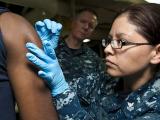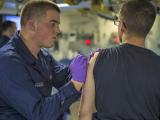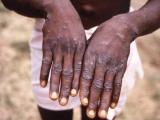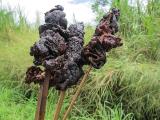Mar 19, 2007 (CIDRAP News) – A 2-year-old Indiana boy is in critical condition in a Chicago hospital with eczema vaccinatum, a rare type of vaccinia virus skin infection that he contracted through contact with his father, a soldier who recently had a smallpox shot.
The boy, who has a history of eczema, a risk factor for severe vaccinia infections, has been ill since early March and is being treated at the University of Chicago's Comer Children's Hospital. He has received several drugs, including an experimental antiviral for smallpox.
The boy's father received smallpox vaccine, in which vaccinia virus is the active ingredient, in late January in preparation for military deployment, according to a Mar 16 statement from the University of Chicago Medical Center (UCMC). But his deployment was delayed, and he was allowed to visit his family in mid-February. During the visit he had close contact with his son.
The boy became ill with a rash in early March and was hospitalized in East Chicago, Ind. When the rash continued to spread, he was taken to UCMC on Mar 3, the UCMC statement said. His mother also has a vaccinia infection, though mild, and is hospitalized with her son.
Infection was nearly fatal
By the weekend of Mar 10 and 11, the boy had a rash over 80% of his body and was close to death, according to Chicago newspaper reports quoting Dr. Madelyn Kahana, chief of pediatric critical care medicine at UCMC. Sepsis was setting in, and he had to be put on a ventilator, the Chicago Tribune reported.
Doctors treated him with vaccinia immune globulin (VIG), the primary recommended therapy for eczema vaccinatum, which was released by the Centers for Disease Control and Prevention (CDC) from the Strategic National Stockpile. He has also been treated with the antiviral cidofovir and an experimental smallpox drug called ST-246, UCMC said.
At the CDC's request, the Food and Drug Administration (FDA) granted emergency permission to try ST-246, according to a Mar 18 report by the Chicago Sun-Times. In experiments, the drug has protected animals from vaccinia and other pox viruses, and it has been tested in a phase 1 clinical trial, according its maker, SIGA Technologies, Inc.
The boy has slowly improved since Mar 11, when treatment with ST-246 began, according to a UCMC pediatrican quoted by the Sun-Times.
Kahana told CIDRAP News today that the boy is still in critical condition and on a ventilator, with the infection involving the full thickness of the epidermis over about 20% of his body. But he has not had any new lesions in about a week, she added.
He was first treated with VIG, followed a few days later by cidofovir and a few days after that by ST-246, Kahana said. "Initially I don't know that either the CDC or the drug company was very excited about letting us use the experimental antiviral, but we didn't have much choice," she said.
She said the child is being given massive doses of VIG: "We're well beyond any limits of the VIG that had previously been established. . . . We've skipped a couple of days [of treatment], but not many."
Kahana said it was difficult to tell which of the drugs is most responsible for the patient's improvement.
He is also on pain medication and receiving wound care" very similar to that of a burn patient," she said.
Initially he needed mechanical ventilation because of "acute hypoxic respiratory failure related to sepsis or systemic inflammatory response," but his need for ventilation is now due to pain medication, she said.
No previous cases in military program
The US military revived its long-discontinued smallpox vaccination program in late 2002, and by June 2006 about 1.1 million service members bound for the Middle East and other high-risk areas had been vaccinated. Until now, no cases of eczema vaccinatum or progressive vaccinia had been reported in the program, according to a Department of Defense (DoD) Web site.
Eczema is a well-known contraindication for smallpox vaccination, and safety guidelines say that vaccinees should avoid contact with anyone with a history of eczema until the vaccine lesion has fully healed. But according to the Sun-Times report, doctors said the sick boy's father didn't know he should stay away from his son after the vaccination.
The Tribune report said it was unclear why the soldier was allowed to have contact with his son so soon after the immunization. An Army spokesman said officials were looking into the matter.
Data mostly from the 1960s suggest that eczema vaccinatum occurred in between 10 and 39 cases out of every million first-time smallpox vaccinees, according to the CDC. But widespread smallpox immunization today could result in a higher rate, because of the large numbers of people with immunity weakened by cancer treatment, other immune-suppressing drugs, and HIV.
The UCMC statement said personnel at Comer Children's Hospital immediately suspected a severe and potentially contagious viral infection when the sick child arrived. Consequently they took extensive precautions to prevent vaccinia from spreading to healthcare workers and other patients, including putting the boy and his mother in a negative-pressure room.
Infection control specialists have carefully documented all staff contacts with the boy and his mother, the statement said. The CDC has contacted people who might have been exposed to the boy before he was hospitalized in Chicago, and no additional cases have been found.
See also:
CDC smallpox site
http://www.bt.cdc.gov/agent/smallpox/index.asp
Journal of Virology report on animal study of ST-246
http://jvi.asm.org/cgi/content/abstract/79/20/13139
Siga Technologies news release on the use of ST-246 in this case
http://www.siga.com/?ID=39
Siga news release on clinical trial of ST-246
http://www.siga.com/?ID=52
DoD smallpox vaccination information
http://www.smallpox.army.mil/event/SPSafetySum.asp
CIDRAP overview of smallpox, including information on risks of vaccination



















